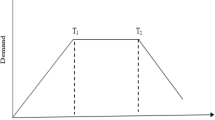Abstract
In this paper, an attempt is made to characterize the preservation technology for deteriorating items in order to reduce the deterioration rate. This model assumes a deteriorating inventory model with trapezoidal type demand by allowing preservation technology cost as a decision variable. Holding cost is assumed to be a time dependent. The model with no shortage case in inventory is first solved. The inventory shortage is discussed next. A solution procedure is presented to determine an optimal replenishment cycle and total cost per unit time, which is a convex function of preservation technology cost. Results have been validated with relevant examples. Sensitivity analysis is performed to show the effect of changes in the parameters on the optimum solution. The analysis of the model shows that the solution of the model is quite stable and can be applied for optimizing the total inventory cost of deteriorating items inventory for the business enterprises where they use the preservation technology to reduce the deterioration rate of the inventory items.












Similar content being viewed by others

References
Bakker M, Riezebos J, Ruud TH (2012) Review of inventory systems with deterioration since 2001. Eur J Oper Res 221(2):275–284
Bhunia AK, Kundu S, Sannigrahi T, Goyal SK (2009) An application of tournament genetic algorithm in a marketing oriented economic production lot-size model for deteriorating items. Int J Prod Econ 119(1):112–121
Blackburn J, Scudder G (2009) Supply chain strategies for perishable products: the case of fresh produce. Prod Oper Manag 18(2):129–137
Chang CT, Teng JT, Goyal SK (2010) Optimal replenishment policies for non-instantaneous deteriorating items with stock-dependent demand. Int J Prod Econ 123(1):62–68
Cheng M, Wang G (2009) A note on the inventory model for deteriorating items with trapezoidal type demand rate. Comput Ind Eng 56(4):1296–1300
Cheng M, Zhang B, Wang G (2011) Optimal policy for deteriorating items with trapezoidal type demand and partial backlogging. Appl Math Model 35(7):3552–3560
Chuang KW, Lin CN, Lan CH (2013) Order policy analysis for deteriorating inventory model with trapezoidal type demand rate. J Netw 8(8):1838–1844
Covert RP, Philip GC (1973) An EOQ model for items with Weibull distribution deterioration. AIIE Trans 5(4):323–326
Dave U, Patel LK (1981) (T, Si) policy inventory model for deteriorating items with time proportional demand. J Oper Res Soc 32(1):137–142
Debata S, Acharya M, Samanta GC (2015) An inventory model for perishable items with quadratic trapezoidal type demand under partial backlogging. Int J Ind Eng Comput 6(2):185–198
Dye CY (2013) The effect of Preservation Technology investment on a non-instantaneous deteriorating inventory model. Omega 41(1):872–880
Dye CY, Hsieh TP (2012) An optimal replenishment policy for deteriorating items with effective investment in preservation technology. Eur J Oper Res 218(1):106–112
Ghare PM, Schrader GH (1963) A model for exponentially decaying inventory system. Int J Ind Eng 14:238–243
Goyal SK, Giri BC (2001) Recent trends in modeling of deteriorating inventory. Eur J Oper Res 134(1):1–16
Hsieh TP, Dye CY (2013) A production inventory model incorporating the effect of preservation technology investment when demand is fluctuating with time. J Comput Appl Math 239(1):25–36
Hsu PH, Wee HM, Teng HM (2010) Preservation technology investment for deteriorating inventory. Int J Prod Econ 124(2):388–394
Kang S, Kim I (1983) A study on the price and production level of the deteriorating inventory system. Int J Prod Res 21(6):449–460
Kouki C, Sahin E, Jemai Z, Dallery Y (2013) Assessing the impact of perishability and the use of time temperature technologies on inventory management. Int J Prod Econ 143(1):72–85
Mishra VK, Singh LS (2011) Deteriorating inventory model for time dependent demand and holding cost with partial backlogging. Int J Manag Sci Eng Manag 6(4):267–271
Musa A, Sani B (2012) Inventory ordering policies of delayed deteriorating items under permissible delay in payments. Int J Prod Econ 136(1):75–83
Singh C, Singh SR (2011) Imperfect production process with exponential demand rate, Weibull deterioration under inflation. Int J Oper Res 12(4):430–445
Singh SR, Gupta V (2014) Supply chain production model with preservation technology under fuzzy environment. Int J Ind Eng Comput 5(3):459–474
Tripathy CK, Mishra U (2010) An inventory model for weibull deteriorating items with price dependent demand and time-varying holding cost. Appl Math Sci 4(44):2171–2179
Tripathy CK, Mishra U (2011) An EOQ model with time dependent Weibull deterioration and ramp type demand. Int J Ind Eng Comput 2(2):307–318
Uthayakumar R, Rameswari M (2012) An economic production quantity model for defective items with trapezoidal type demand rate. J Optim Theory Appl 154(3):1055–1079
Yang PC, Wee HM (2006) A collaborative inventory system with permissible delay in payment for deteriorating items. Math Comput Model 43(3–4):209–221
Yong H, Huang H (2013) Optimizing inventory and pricing policy for seasonal deteriorating products with preservation technology investment. J Ind Eng. Article ID 793568. doi:10.1155/2013/793568
Zhao L (2014) An inventory model under trapezoidal type demand, Weibull distributed deterioration, and partial backlogging. J Appl Math. Article ID 747419. doi:10.1155/2014/747419
Acknowledgments
The authors would like to thank the referee for their valuable comments.
Author information
Authors and Affiliations
Corresponding author
Rights and permissions
About this article
Cite this article
Mishra, U. An inventory model for deteriorating items under trapezoidal type demand and controllable deterioration rate. Prod. Eng. Res. Devel. 9, 351–365 (2015). https://doi.org/10.1007/s11740-015-0625-8
Received:
Accepted:
Published:
Issue Date:
DOI: https://doi.org/10.1007/s11740-015-0625-8



